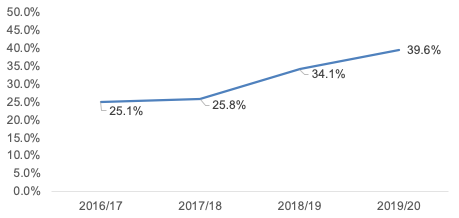Vision for Justice in Scotland: measurement framework
Measurement framework to support the delivery of the Vision for Justice in Scotland.
We work together to address the underlying causes of crime and support everyone to live full and healthy lives
We work together to mitigate the impact of poverty and disadvantage in bringing people into contact with the justice system

There was little change to the previously reported pattern of arrivals to prison being most likely from the 10% most deprived areas of Scotland – a consistent pattern over the past decade.
The 10% most deprived areas of Scotland accounted for 31% of all arrivals to prison in 2021-22 - a small reduction from 34% in 2020-21.
Source: Scottish Prison Population Statistics 2021-22 - gov.scot (www.gov.scot)
Gap between most deprived 15% and rest of Scotland in experiencing crime

Those living in the 15% most deprived areas were 5.3 percentage points more likely to experience any crime than the rest of Scotland in 2019/20.
Due to the restrictions put in place during the COVID-19 pandemic, no survey was run during the 2020/21 financial year. The 2021/22 SCJS will be published at the end of November 2023. This data is expected to be produced annually.
Source: Scottish Crime and Justice Survey 2019/20
We work with partners to improve the mental and physical wellbeing of those who come into contact with the justice system

One fifth of prisoners who responded reported that they were worried that alcohol will be a problem for them when they are released from prison (19%). When asked if they were concerned that their drug taking would be a problem for them upon release, 23% responded ‘yes' which is consistent with previous survey results (22% in 2017 and 24% in 2015).
The Prisoner Survey is being refreshed for delivery in 2024. The wording and definitions related to drugs and alcohol will be revisited to ensure it reflects current best practice, therefore figures over time may not be directly comparable.
Source: SPS Prisoner Survey 2019
We prevent and experience less harm caused by alcohol and drugs

In 2019, 45% of prisoners stated that they had been under the influence of drugs at the time of their offence, while four in ten who completed a questionnaire reported being drunk at the time of their offence (40%).
The Prisoner Survey is being refreshed for delivery in 2024. The wording and definitions related to drugs and alcohol will be revisited to ensure it reflects current best practice, therefore figures over time may not be directly comparable.
Source: SPS Prisoner Survey 2019

Offenders were believed to be under the influence of alcohol or drugs in 39.6% of violent incidents where victims were able to say something about the offender in 2019/20.
It should be noted that in 14% of violent incidents (where victims were able to say something about the offender) the victim did not know if the offender was under the influence of alcohol or not.
Due to the restrictions put in place during the COVID-19 pandemic, no survey was run during the 2020/21 financial year. The 2021/22 SCJS will be published at the end of November 2023. This data is expected to be produced annually.
Source: Scottish Crime and Justice Survey 2019/20
We require less support from emergency policing responses due to mental ill health

The proportion of persons declaring one or multiple vulnerabilities (including mental health issues) remains broadly stable although increases can be seen in total numbers which may be partially explained by the increase in throughput.
Source: How we are performing – Police Scotland – Q4 2022/23
We must #KeepthePromise

In 2019, one quarter of those in prison indicated that during their upbringing they had been in care (25%), consistent with previous surveys.
The Prisoner Survey is being refreshed for delivery in 2024. The wording and definitions related to a person being care experienced will be revisited to ensure it reflects current best practice, therefore figures over time may not be directly comparable.
Source: SPS Prisoner Survey 2019
Young people are less likely to commit crimes and the Whole System approach to preventing offending has been extended

In 2022/23, 2,637 children aged between 12 and 17 years were referred to the Reporter on offence grounds. These children were referred for 11,702 alleged offences on 6,498 referrals. Within these groupings, the most common types of alleged offences were assault, threatening or abusive behaviour and vandalism.
Source: SCRA (2022/23)
We all participate in healthier and more respectful relationships

16.5% of adults said they had experienced at least one incident of partner abuse since the age of 16 (2018/20). Since the age of 16, women were almost twice as likely as men to have experienced partner abuse (21.2% and 11.2% respectively).

11.8% of adults experienced at least one type of stalking and harassment in the 12 months prior to interview (2018/20).

Overall, 3.6% of adults said they had experienced at least one type of serious sexual assault since the age of 16. A greater proportion of women than men have experienced serious sexual assault both since the age of 16 (6.1% compared with 0.8%). These figures are unchanged since 2016/18.
Contact
Email: Justice_analysts@gov.scot
There is a problem
Thanks for your feedback